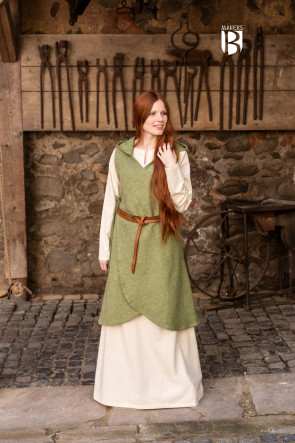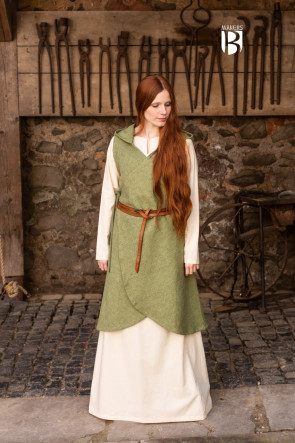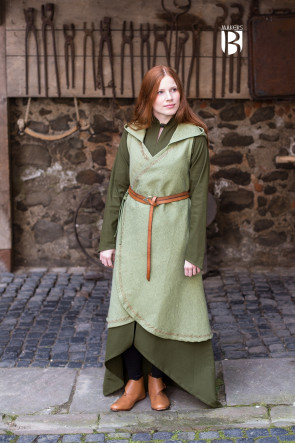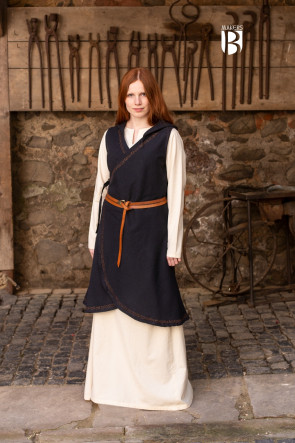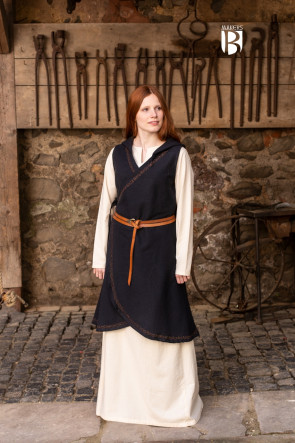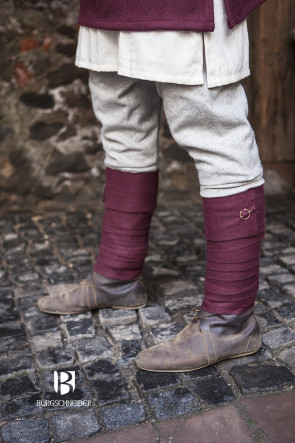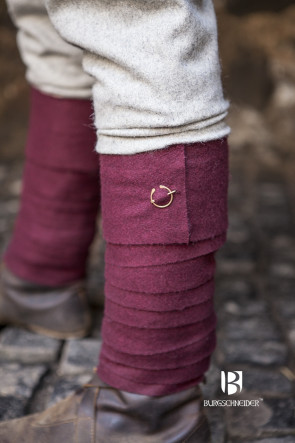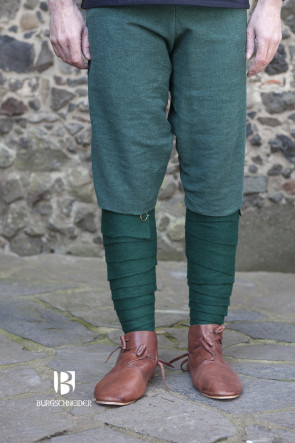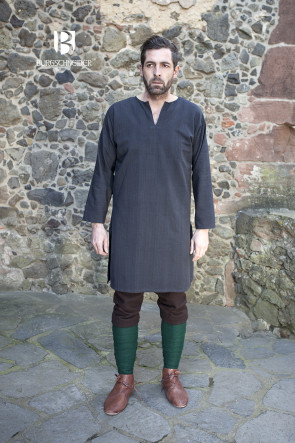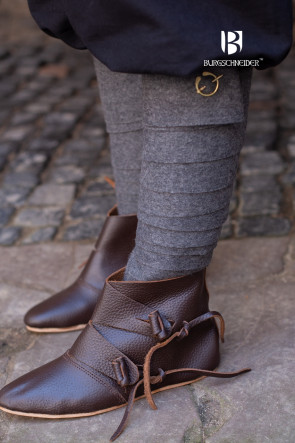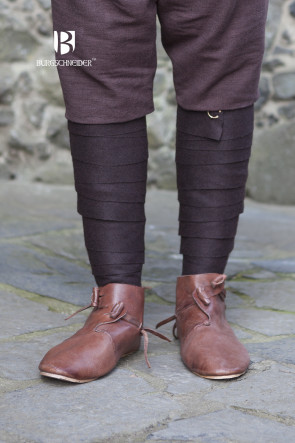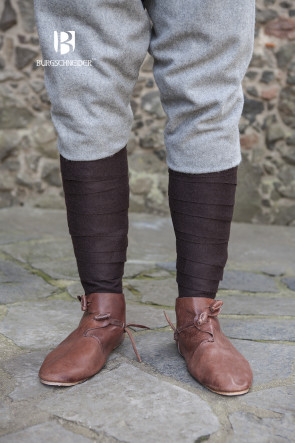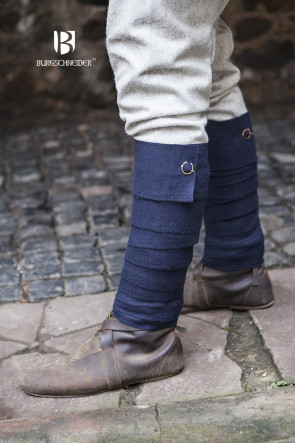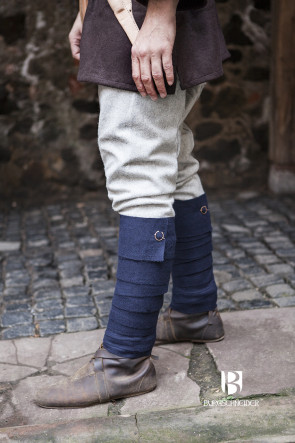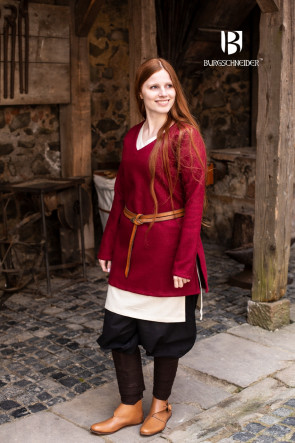Fantasy Kriegerin
As distinguished from historical reenactment, the fantasy genre lacks any gender requirements for assuming a certain role—quite the opposite is the case: fantasy’s very strengths and advantages lie in diversity and the depiction of alternative models for society. So perhaps that’s why skillful female warriors are popular characters in a lot of fantasy narratives—be it in movies, novels, videogames or LARP—with hundreds of tales telling of Viking shield maidens, Valkyries, Amazons, Joan of Arc, and other fighting women the world over. Time and again, these women have been depicted in movies, TV shows, novels, and LARP.
Compelling female warriors vs. outdated clichés
Female warriors combine attributes of femininity with traits commonly deemed as “male”––strength, brutishness, and aggression, for instance—thus shattering traditional gender stereotypes that still mark our modern society, and creating strong role models for a newly emancipated culture. Because there have always been female human warriors, even from the beginning of human history, in our world today—contrary to simply being a figment of modern fiction—they are actually experiencing a renaissance.
While every fantasy world has its very own take on female warriors, certain principles apply to almost every universe. Consequently, these principles are considered either useful stereotypes for the depiction of a female warrior or outdated relics of the male-dominated fantasy genre of previous centuries.
What makes a compelling costume for a female warrior?
Close examination of existing movies and videogames quickly reveals disparities in the clothing and armor of male and female warriors. While male warriors usually are dressed in garb and accessories that jibe with historical sources, their female counterparts wear revealing dresses or “bikini mail” that rarely covers more than their nipples or pubic region. This is often combined with high heels, in which even proficient women can hardly run, let alone fight. Although these depictions obviously lack common-sense logic, they are quite pervasive, leading girls and women astray when assembling their warrior’s outfit, even though the same standards apply for male and female warriors alike:
Female warriors—no less than male ones—need to protect their bodies from harm by enemy attacks. This requirement demands the same kind of comfortable, sturdy, and expedient clothing and armor afforded to their male counterparts. Only then will a female warrior become believable and truly be taken seriously as an opponent.
-
Wrap Dress Runa - Linden Green
- Material: 100% Cotton
- Genre: Fictional
- Sizes: S/M - L/XL - XXL/XXXL
- Maker: Butterfly Garden
€54.90 -
Wrap Dress Dala - Linden Green
- Material: 100% Cotton
- Genre: Fictional
- Sizes: S/M - L/XL - XXL/ XXXL
- Maker: Butterfly Garden
€59.90 -
Wrap Dress Dala - Black
- Material: 100% Cotton
- Genre: Fictional
- Sizes: S/M - L/XL - XXL/ XXXL
- Maker: Butterfly Garden
€59.90 -
Wool Winingas Aki - Red
Winingas have been worn since the Iron Age. The Romans at Hadrian's Wall used them, as did the Germanic tribes, Byzantines, Franks, Alamanni, Bavarians, Wends (Slavs), and later in the Middle Ages, the Normans and Vikings. Winingas were widespread throughout Central and Northern Europe.
Learn More
In the beginning, winingas served as a substitute for socks. From foot to lower leg, they are wrapped over the pants to below the knee and fixed with a fibula to protect and keep the wearer warm.
On the basis of textile finds in Damendorf, Oberaltendorf, Bernuthsfeld and the Thorsberg moor, there’s proof these have been worn from the 2nd to the 8th century, and also on the carpet of Bayeux from the year 1066, winingas are shown.
Our Wool Winingas Aki stay in this tradition and are made of wool with the dimensions 380cm x 10cm. Of course, we supply two winingas, you do not buy socks individually.€19.90 -
Wool Winingas Aki - Green
Winingas have been worn since the Iron Age. The Romans at Hadrian's Wall used them, as did the Germanic tribes, Byzantines, Franks, Alamanni, Bavarians, Wends (Slavs), and later in the Middle Ages, the Normans and Vikings. Winingas were widespread throughout Central and Northern Europe.
Learn More
In the beginning, winingas served as a substitute for socks. From foot to lower leg, they are wrapped over the pants to below the knee and fixed with a fibula to protect and keep the wearer warm.
On the basis of textile finds in Damendorf, Oberaltendorf, Bernuthsfeld and the Thorsberg moor, there’s proof these have been worn from the 2nd to the 8th century, and also on the carpet of Bayeux from the year 1066, winingas are shown.
Our Wool Winingas Aki stay in this tradition and are made of wool with the dimensions 380cm x 10cm. Of course, we supply two winingas, you do not buy socks individually.€19.90 -
Wool Winingas Aki - Darkgrey
Winingas have been worn since the Iron Age. The Romans at Hadrian's Wall used them, as did the Germanic tribes, Byzantines, Franks, Alamanni, Bavarians, Wends (Slavs), and later in the Middle Ages, the Normans and Vikings. Winingas were widespread throughout Central and Northern Europe.
Learn More
In the beginning, winingas served as a substitute for socks. From foot to lower leg, they are wrapped over the pants to below the knee and fixed with a fibula to protect and keep the wearer warm.
On the basis of textile finds in Damendorf, Oberaltendorf, Bernuthsfeld and the Thorsberg moor, there’s proof these have been worn from the 2nd to the 8th century, and also on the carpet of Bayeux from the year 1066, winingas are shown.
Our Wool Winingas Aki stay in this tradition and are made of wool with the dimensions 380cm x 10cm. Of course, we supply two winingas, you do not buy socks individually.€19.90 -
Wool Winingas Aki - Brown
Winingas have been worn since the Iron Age. The Romans at Hadrian's Wall used them, as did the Germanic tribes, Byzantines, Franks, Alamanni, Bavarians, Wends (Slavs), and later in the Middle Ages, the Normans and Vikings. Winingas were widespread throughout Central and Northern Europe.
Learn More
In the beginning, winingas served as a substitute for socks. From foot to lower leg, they are wrapped over the pants to below the knee and fixed with a fibula to protect and keep the wearer warm.
On the basis of textile finds in Damendorf, Oberaltendorf, Bernuthsfeld and the Thorsberg moor, there’s proof these have been worn from the 2nd to the 8th century, and also on the carpet of Bayeux from the year 1066, winingas are shown.
Our Wool Winingas Aki stay in this tradition and are made of wool with the dimensions 380cm x 10cm. Of course, we supply two winingas, you do not buy socks individually.€19.90 -
Wool Winingas Aki - Blue
Winingas have been worn since the Iron Age. The Romans at Hadrian's Wall used them, as did the Germanic tribes, Byzantines, Franks, Alamanni, Bavarians, Wends (Slavs), and later in the Middle Ages, the Normans and Vikings. Winingas were widespread throughout Central and Northern Europe.
Learn More
In the beginning, winingas served as a substitute for socks. From foot to lower leg, they are wrapped over the pants to below the knee and fixed with a fibula to protect and keep the wearer warm.
On the basis of textile finds in Damendorf, Oberaltendorf, Bernuthsfeld and the Thorsberg moor, there’s proof these have been worn from the 2nd to the 8th century, and also on the carpet of Bayeux from the year 1066, winingas are shown.
Our Wool Winingas Aki stay in this tradition and are made of wool with the dimensions 380cm x 10cm. Of course, we supply two winingas, you do not buy socks individually.€19.90 -
Wool Winingas Aki - Black
Winingas have been worn since the Iron Age. The Romans at Hadrian's Wall used them, as did the Germanic tribes, Byzantines, Franks, Alamanni, Bavarians, Wends (Slavs), and later in the Middle Ages, the Normans and Vikings. Winingas were widespread throughout Central and Northern Europe.
Learn More
In the beginning, winingas served as a substitute for socks. From foot to lower leg, they are wrapped over the pants to below the knee and fixed with a fibula to protect and keep the wearer warm.
On the basis of textile finds in Damendorf, Oberaltendorf, Bernuthsfeld and the Thorsberg moor, there’s proof these have been worn from the 2nd to the 8th century, and also on the carpet of Bayeux from the year 1066, winingas are shown.
Our Wool Winingas Aki stay in this tradition and are made of wool with the dimensions 380cm x 10cm. Of course, we supply two winingas, you do not buy socks individually.€19.90 -
Wool Tunic Hyria - Red
- Material: Wool Blend
- Genre: Historic
- Sizes: S - XXXL
- Reference: Bernuthsfeld Tunic
€59.90







